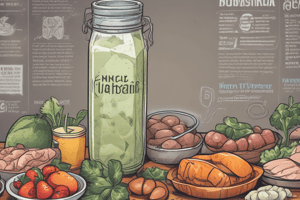Podcast
Questions and Answers
What percentage of an egg's weight is protein?
What percentage of an egg's weight is protein?
12%
What is the approximate protein content of a 3-ounce serving of steamed broccoli?
What is the approximate protein content of a 3-ounce serving of steamed broccoli?
1 g
What is the serving size of pepperoni pizza in Table 7.3?
What is the serving size of pepperoni pizza in Table 7.3?
2 slices (246 g)
How much protein is in a 1-cup serving of vanilla ice cream?
How much protein is in a 1-cup serving of vanilla ice cream?
What is the protein content of a small banana?
What is the protein content of a small banana?
How much protein is in 2 tablespoons of peanut butter?
How much protein is in 2 tablespoons of peanut butter?
What is the approximate protein content of a 4-ounce serving of roasted chicken breast?
What is the approximate protein content of a 4-ounce serving of roasted chicken breast?
What is the general protein content of most plant foods per ounce?
What is the general protein content of most plant foods per ounce?
What is the primary source of gelatin?
What is the primary source of gelatin?
Why does eating gelatin not make fingernails stronger?
Why does eating gelatin not make fingernails stronger?
What parts of plants contain more protein than others?
What parts of plants contain more protein than others?
How much protein does a 3-ounce serving of almonds, dry-roasted peanuts, or sunflower seed kernels supply?
How much protein does a 3-ounce serving of almonds, dry-roasted peanuts, or sunflower seed kernels supply?
What is characteristic of mature peas, lentils, and most kinds of beans?
What is characteristic of mature peas, lentils, and most kinds of beans?
What is the key characteristic of high-quality proteins?
What is the key characteristic of high-quality proteins?
Why are egg proteins considered high-quality?
Why are egg proteins considered high-quality?
What are the exceptions to the rule that most plant foods are not sources of high-quality proteins?
What are the exceptions to the rule that most plant foods are not sources of high-quality proteins?
What is the significance of understanding protein quality?
What is the significance of understanding protein quality?
What is the potential health benefit of eating foods made from soybeans?
What is the potential health benefit of eating foods made from soybeans?
Flashcards are hidden until you start studying
Study Notes
Proteins in Foods
- Nearly all foods contain protein, but no naturally occurring food is 100% protein.
- Protein comprises about 20 to 30% of the weight of a piece of beef, 25% of the weight of drained tuna fish, and 12% of an egg's weight.
- Animal foods generally provide higher amounts of protein than similar quantities of plant foods.
High-Quality vs. Low-Quality Proteins
- A high-quality protein contains all essential amino acids in amounts that support protein deposition in muscles and other tissues, as well as a young child's growth.
- High-quality proteins are well digested and absorbed by the body.
- Meat, fish, poultry, eggs, and milk and other dairy products contain high-quality proteins.
- Egg protein generally rates very high for protein quality because it is easy to digest and has a pattern of essential amino acids that closely resembles that needed by humans.
- A low-quality protein lacks one or more of the essential amino acids or contains inadequate amounts of these nutrients.
Limiting Amino Acids
- The essential amino acids that are in relatively low amounts are referred to as limiting amino acids because they reduce the protein's ability to support growth, repair, and maintenance of tissues.
- In most instances, lysine, tryptophan, threonine, and the sulfur-containing amino acids methionine and cysteine are the limiting amino acids in foods.
Plant Foods as Protein Sources
- Certain parts of plants contain more protein than other parts.
- Seeds, tree nuts, and legumes supply more protein per serving than servings of fruit or the edible leaves, roots, flowers, and stems of vegetables.
- A 3-ounce serving of almonds, dry-roasted peanuts, or sunflower seed kernels supplies about 20 g of protein.
- Mature peas, lentils, and most kinds of beans contain more protein and complex carbohydrate than fat.
Quinoa and Soy Protein
- Quinoa is an exception to the rule that most plant foods are not sources of high-quality proteins.
- The quality and amount of protein in quinoa seeds are superior to those of many cereal grains.
- Soy protein is comparable to that of most animal proteins.
- Processed soybeans are used to make a variety of nutritious foods, including soy milk, infant formula, and meat substitutes.
Studying That Suits You
Use AI to generate personalized quizzes and flashcards to suit your learning preferences.




